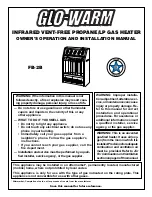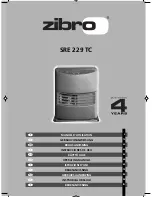
21
metallic vent pipe and fittings with thermal insulation
is prohibited.
CATEGORY IV APPLIANCES
Category IV appliances operate with a positive vent (exhaust)
static pressure and with vent-gas temperatures low enough to
produce condensate in the vent piping.
POWER VENT CONFIGURATIONS
Power Vent configurations derive all combustion air from the room
where they are installed and discharge all flue gases to the outdoor
atmosphere through a sealed vent (exhaust) pipe. Power vent
configurations have one vent pipe connected to the water heater
which can be terminated in a vertical or horizontal arrangement.
DIRECT VENT CONFIGURATIONS
Direct Vent configurations derive all combustion air directly from
the outdoor atmosphere through a sealed intake air pipe and
discharge all flue gases to the outdoor atmosphere through a
sealed vent (exhaust) pipe. Direct Vent configurations have two
pipes connected to the water heater, one vent pipe and one intake
air pipe. Direct Vent configurations can be terminated in one of
seven different arrangements. See
GENERAL VENTING INSTRUCTIONS
These instructions must be followed on all installations.
1. DO NOT
install the water heater in a Power Vent configuration
unless there is adequate supply of fresh air, see
If the installation space does not provide an
adequate supply of fresh air the water heater must be installed
in a Direct Vent configuration.
2.
If the water heater is to be installed in a beauty shop, barber
shop, cleaning establishment, a laundry with dry cleaning
equipment or any space with contaminated air it is imperative
that the water heater(s) be installed in a Direct Vent configuration
so that all air for combustion is derived from the outdoor
atmosphere.
3. The vent and intake air piping must terminate outdoors.
4.
The minimum clearance from combustible materials for the
vent (exhaust) and intake air piping shall be 0 inches. Vent
piping passing through a combustible wall or ceiling must be a
continuous run (no joints).
5.
The water heater must be protected from freezing downdrafts
during shutdown periods.
6. The intake air and vent pipes
must not be combined
with pipes
from any other appliance unless they meet the requirements in
the separate manual for common venting of heaters covered
by this manual. See
Common Vent Kit Instructions.
7.
Locate the water heater where the vent (exhaust) and intake
air piping will remain within the maximum equivalent lengths
allowed. See
8.
Do not install the vent or intake air piping in a manner that will
allow water to be trapped in the piping.
9.
Vent pipes and air intakes must be pitched a minimum of a
1/4 inch per foot back to the water heater (to allow drainage
of condensate).
10.
Do not anchor the vent or intake air pipe directly to framed walls,
floors or ceilings unless rubber isolation pipe hangers are used
to prevent vibration noise from being transmitted.
11.
Use only approved vent/intake air pipe sizes and materials. See
12.
Use only factory supplied vent and intake air, concentric or low
13. Do not locate the vent (exhaust) or intake air terminations where
they would be objectionable due to noise at the termination(s).
This includes locations close to or across from windows and
doors.
14.
Direct venting into dead air spaces such as alleys, atriums,
and inside corners can cause recirculation of flue gases.
Recirculation of flue gases will cause sooting, premature failure
of the heat exchanger and icing of the combustion air intake
VENTING INSTALLATION
Breathing carbon monoxide can cause brain damage or death.
Always read and understand the instruction manual.
Install vent system in accordance with codes.
Do not operate water heater if exposed to flooding or
water damage
Special consideration must be taken with installations
above 10,000 feet (3,048 m) refer to high altitude
section of this manual.
Breathing Hazard - Carbon Monoxide Gas
•
•
Do not operate if soot buildup.
•
Do not obstruct water heater air intake with insulating
jacket or blanket.
•
Do not place chemical vapor emitting products near
water heater.
•
Gas and carbon monoxide detectors are available.
•
Never operate the heater unless it is vented to the
outdoors and has adequate air supply to avoid risks
of improper operation, fire, explosion or asphyxiation.
•
Analyze the entire vent system to make sure that
condensate will not become trapped in a section of
vent pipe and therefore reduce the open cross
sectional area of the vent.
•
•
Never operate the water heater unless it is vented to outdoors.
The instructions in this section of the manual must be followed
to avoid choked combustion or recirculation of flue gases. Such
conditions cause sooting of the combustion chamber, burners,
and flue tubes, and creates a risk of asphyxiation.
GENERAL VENTING INFORMATION
The water heaters covered in this manual are Category IV
appliances and may be installed in either a Power Vent or Direct
Vent configuration.
APPROVED MATERIALS
Approved vent and intake air pipe materials that may be used in
the United States:
PVC pipe materials:
•
DWV ASTM-D2665 or CSA B181.2
•
Schedule 40, 80, 120 ASTM-D1785 or CSA B137.3
•
SDR Series ASTM-2241 or CSA B137.3
CPVC pipe materials:
•
CPVC 41 ASTM-D2846 or CSA B137.6
•
Schedule 40, 80 ASTM-F441 or CSA B137.6
•
SDR Series ASTM-F442
Polypropylene
28.
•
M & G Duravent PolyPro vent system
•
Centrotherm InnoFlue vent system
AL29-4C Stainless Steel
- See page
29.
•
HeatFab Saf-T Vent
• Duravent FasNSeal
Approved vent pipe materials that must be used in Canada:
•
ULC S636 PVC / CPVC
•
ULC S636 Polypropylene - See page
•
AL29-4C Stainless Steel - See page
29.
Approved intake air pipe materials that must be used in Canada:
PVC pipe materials:
•
DWV ASTM-D2665 or CSA B181.2
•
Schedule 40, 80, 120 ASTM-D1785 or CSA B137.3
•
SDR Series ASTM-D2241 or CSA B137.3
CPVC pipe materials:
•
CPVC 41 ASTM-D2846 or CSA B137.6
•
Schedule 40, 80 ASTM-F441 or CSA B137.6
•
SDR Series ASTM-F442
Polypropylene -
•
M & G Duravent PolyPro vent system
•
Centrotherm InnoFlue vent system
AL29-4C Stainless Steel -
See page 29.
•
HeatFab Saf-T Vent
• Duravent FasNSeal
Note:
The use of cellular core PVC (ASTM F891), cellular
core CPVC, or Radel
®
(polyphenolsulfone) in non-
metallic venting systems is prohibited. Covering non-
Содержание SUF 60120 THRU
Страница 67: ...67 WIRING DIAGRAM Figure 67 Wiring Diagram...
Страница 77: ...77 NOTES...
Страница 78: ...78 NOTES...
Страница 79: ...79 NOTES...
















































